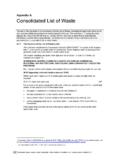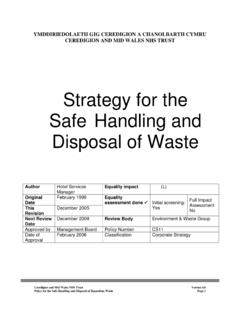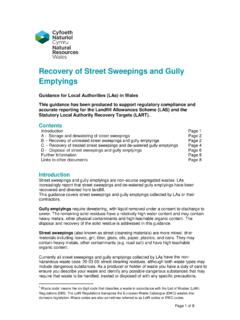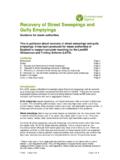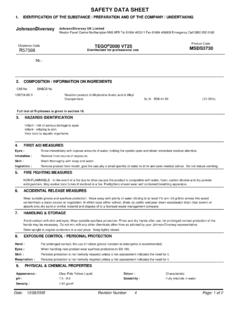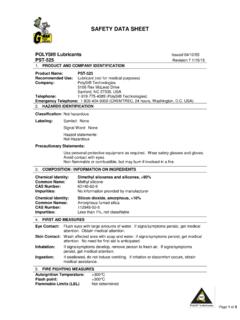Transcription of Disposing of pesticide waste - Health and Safety …
1 93 Disposing of pesticide This part of the code gives guidance on handling and Disposing of pesticide waste (includingconcentrates, ready-to-use formulations and pesticide solutions), contaminated material andequipment and pesticide Change to the law for farmers and growersDefra has brought in regulations that apply to waste from agricultural premises (see The WasteManagement (England and Wales) Regulations 2006 in annex A). These regulations place similarrestrictions on farmers and growers to those that already apply in amenity and forestry areas. Ifyou cause any pollution of air, water or soil, you can be prosecuted. Farmers and growers shouldfollow the guidance in this code to make sure they dispose of waste pesticides in a safe and legalway to keep any unwanted effect on the environment or humans as low as possible.
2 To reduce the amount of waste you produceIf you reduce your use of pesticides , you will also reduce the amount of waste pesticide andempty containers you produce, and you will save money. You should consider the followingquestions: Do you need to use the pesticide and, if you do, can you reduce its use? Do you have suitable pesticides currently in stock and can you order less new stock? Have you chosen the most suitable pack sizes? Can you manage and control the use of pesticides any better? Can you use any of the following methods to reduce packaging waste and reduce thewashings produced? Soluble packs Returnable containers Closed-transfer systems Flushing systems for low-volume sprayers Direct-injection systems Rounding down your calculations of the amount of pesticide needed when filling yoursprayer to allow you to dispose of the washings on an under-dosed area (or using asuitable electronic sprayer controller to achieve the same result) Will your contractor or distributor take back properly cleaned (using a pressure rinsingdevice or manually rinsed at least three times) empty containers?
3 Section How to dispose of unwanted pesticide concentrates andready-to-use formulations?Whenever possible, use up pesticides in the approved way. When a product s approval has beenwithdrawn or amended (for commercial, Safety or other reasons), a wind-down period is given(except when there are major Safety concerns) to allow remaining stocks of the product to beused up. The website at gives details of the approval status of individualproducts and details of reviews which may affect a range of products. By checking thisinformation, or asking your supplier, the manufacturer or an adviser, you should be able to avoidhaving to dispose of unapproved products. Similarly, by managing your chemical store properly, you should be able to avoid having todispose of pesticides because they have deteriorated or because products are out of should avoid storing an unwanted pesticide , and it is illegal to do so if the approval forstoring and using it has been a container (or other packaging) is damaged, but the product is still approved for use, you maybe able to carefully transfer the product to the equipment used to apply it, leaving only thecontainer to be disposed of.
4 Despite good management, you may have some concentrates or ready-to-use pesticides that youneed to dispose of. You should never dilute an unwanted concentrate in order to dispose of it asdilute pesticide waste . You should consider the following points: Firstly, ask your supplier if they will take back any unwanted, unused pesticides that arepackaged, labelled and of good quality; pesticide concentrates are likely to be hazardous waste (previously known as specialwaste ) and may present a significant risk to the environment or to humans. Handling anddisposing of this type of waste is tightly controlled and you will need to use a registeredcarrier (registered with the Environment Agency) and a licensed waste -disposal contractor(you will be able to find one in The Phone Book); You must store unwanted concentrates and ready-to-use formulation in your chemicalstore to make sure they are secure and that any spills will be contained; You (or the carrier if you use one), must fill in a consignment note and pay a fee to theEnvironment Agency if you are moving or Disposing of hazardous waste .
5 You (as thewaste producer) and the people transporting and receiving the waste must keep copies ofthe consignment notes for at least three years. Also, you must not move hazardouswaste until the appropriate period for notice has passed; When you have filled in the necessary consignment notes, you should pass the unwantedconcentrates to a licensed waste -disposal contractor;You should know about the HSE advice on storing pesticides given in the HSE Guidance NoteAS 16 Guidance on storing pesticides for farmers and other professional users .Section 595 As the producer of the waste , you must make sure that the person who takes your wasteis registered to take it and can transport it safely, and that it will be safely disposed ofor recycled; You must also fill in a waste transfer note and provide a written description of the waste (you can write this on the transfer note itself) using the appropriate European WasteCatalogue (EWC) codes.
6 Both you and the waste -disposal contractor must keep copies ofthe transfer note and written description for two years. If the waste is hazardous and youhave filled in a consignment note , you do not also need to fill in a waste transfer note ; If you can transport your own unwanted pesticides safely and legally, you can take these toa licensed treatment or disposal site, after checking whether the site will accept your waste . For pesticide products which are applied undiluted and without a carrier (for example, ready-to-use formulations, granules, dusts, pellets and baits), you should be able to apply the product withno, or very little, extra product left in the equipment. The general guidance on cleaningapplication equipment also applies to these types of pesticide , although equipment used forapplying solid pesticide is not usually cleaned using water.
7 Hazardous waste is defined under the European Hazardous waste Directive 1991 (see annex A)and the EU has produced the European waste Catalogue (EWC) which lists all wastes (whetherhazardous or not). The EWC also states whether materials that can be dangerous are classified as hazardous waste under all circumstances or only when a hazardous substance is present above acertain concentration. You can see the EWC and get guidance on deciding whether your waste is hazardous waste on the Environment Agency website ( ). How to dispose of dilute pesticide wasteIf you are spraying a pesticide , you should be able to do so with no, or very little, spray solutionleft over. Planning this will reduce your waste disposal problems and will save you , in other situations (such as when you are applying a pesticide as a before planting orafter harvesting dipping treatment) you may not always be able to avoid having dilute pesticideleft over at the end of the treatment.
8 When you are treating several sites, one after another, using the same pesticide and the sameequipment, you may be able to use left over spray from one site to treat another, if you cantransport the pesticide safely and legally. You must dispose of all dilute pesticide waste (including any leftover pesticides and all sprayerwashings) safely and legally to protect humans, wildlife and the environment, especiallygroundwater and surface can get more information on hazardous waste from The Chartered Institution of WastesManagement website ( ). If you need more guidance, contact the Environment Agency or your local of pesticide waste96 When you have finished applying the pesticide , clean both the inside and the outside of allequipment you have used. By thoroughly cleaning your application equipment, in line with themanufacturer s instructions, you will help to: reduce any risk from handling contaminated surfaces; prevent damage to other crops and areas which will be treated later using the sameequipment; and reduce the risk of cleaning your equipment you should read and follow the label instructions on: using appropriate PPE when handling contaminated surfaces; and carrying out any decontamination procedures relating to the particular product (forexample, some herbicides need to be de-activated with ammonia-based cleaning agents).
9 If possible, you should clean the equipment you have used (inside and out) at the site of thetreatment, rather than having a single, dedicated site for cleaning. You should use any built-inrinsing systems that are fitted to clean the inside of the equipment quickly and effectively whileusing the minimum volume of rinse water. Similarly, a hose and brush attachment (which isavailable on some sprayers and can be fitted to others) will help you to clean the outside of theequipment more effectively than a high pressure spray gun, and will use less water. Repeatedtank washing, each using a small amount of water, will achieve better results than a single rinseusing a large amount of water and will also produce less washings. As well as cleaning the tank,you will also need to make sure that all pipes, hoses, filters, valves, nozzles and induction systemsare thoroughly cleaned.
10 All facilities for washing equipment should be designed to make surethat the pesticide solution cannot get into your washing water under any options for Disposing of dilute pesticide waste include the following: You can apply the contaminated water to the treated or untreated crop or area within theterms of the product approval. (But make sure you do not go over the maximum dose.); You can store the contaminated water in a suitable container until a licensed waste -disposalcontractor can collect it;You can get more guidance on cleaning sprayers on the Voluntary Initiative website( ) The HSE report Exposure to spray residues on agricultural equipment (HSE )provides useful, practical guidance on avoiding contamination on the outside of applicationequipment (see ). Section 597 When using pesticides in agriculture, you can only dispose of the dilute waste onto soil orgrass (either directly or fed by the drainage from a hard surface) under the terms of anauthorisation under the Groundwater Regulations (see annex A) issued by the EnvironmentAgency.











